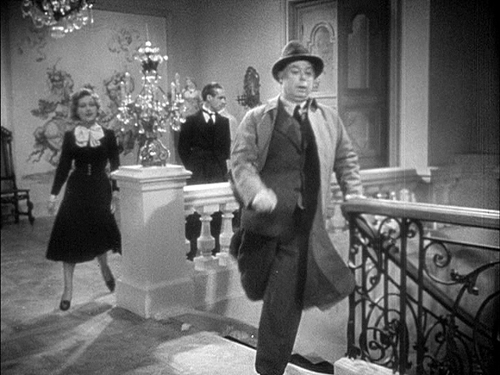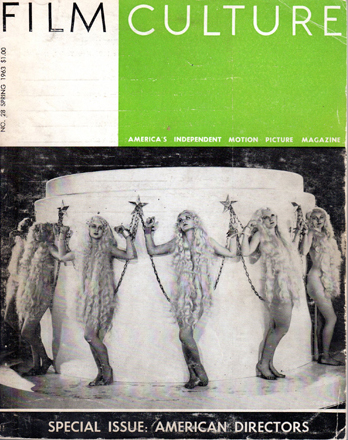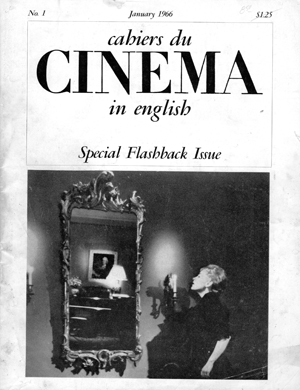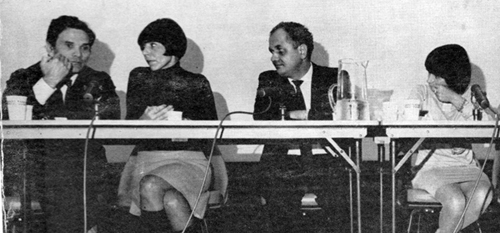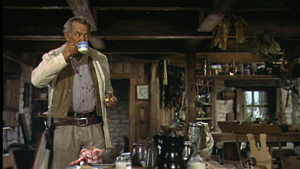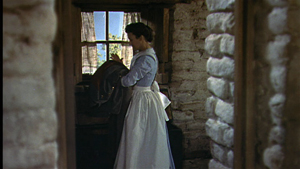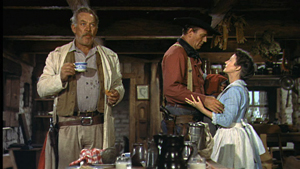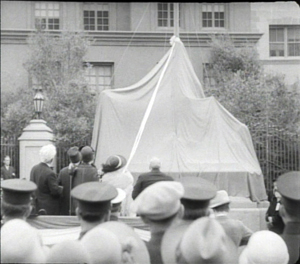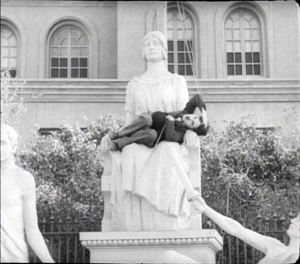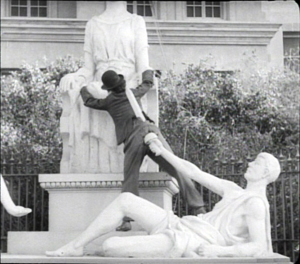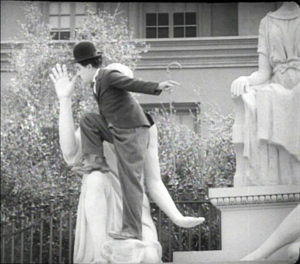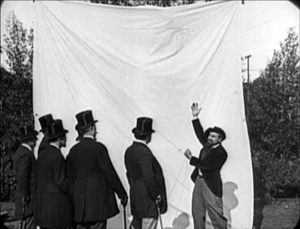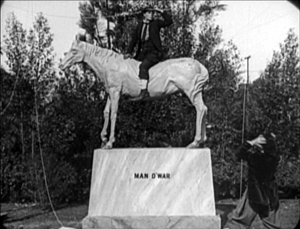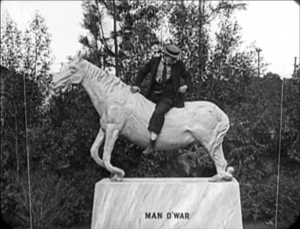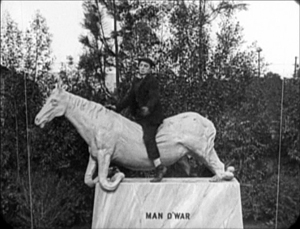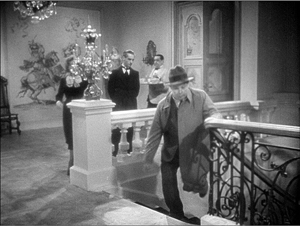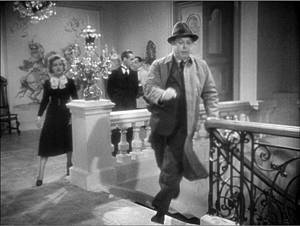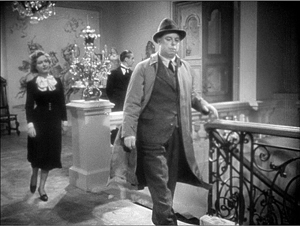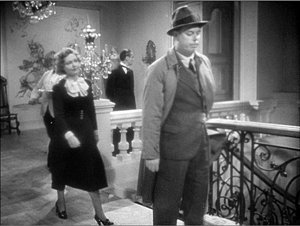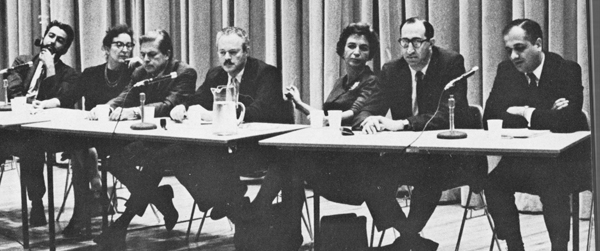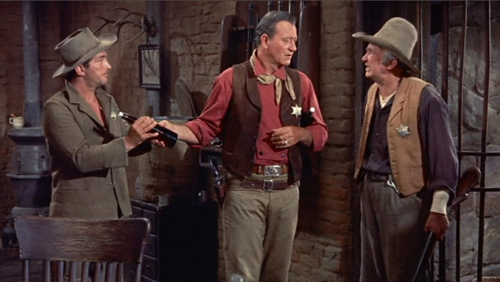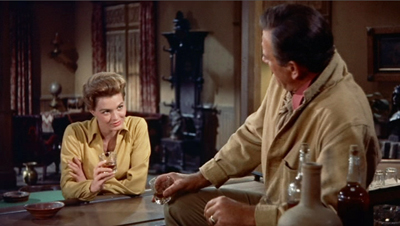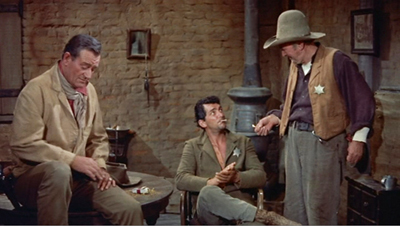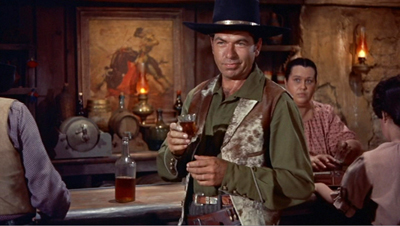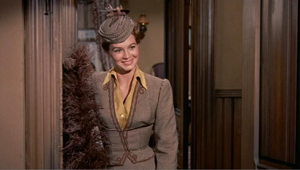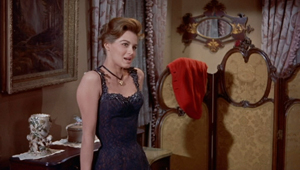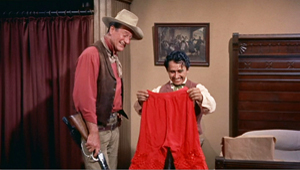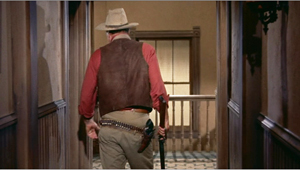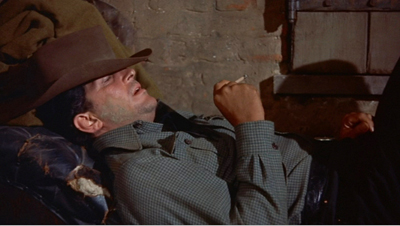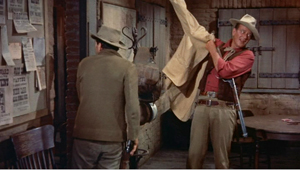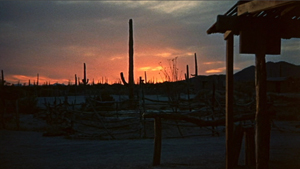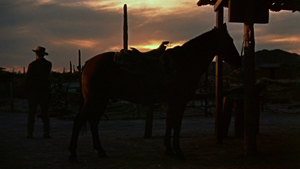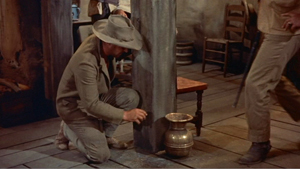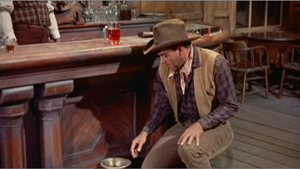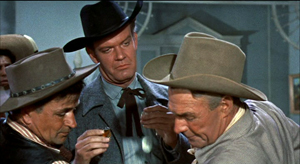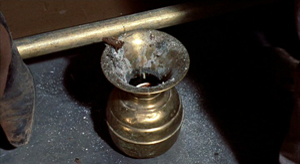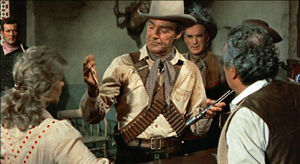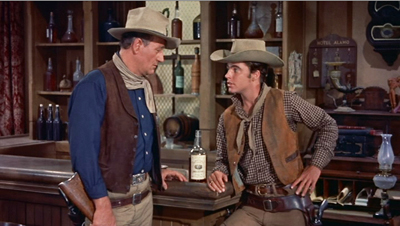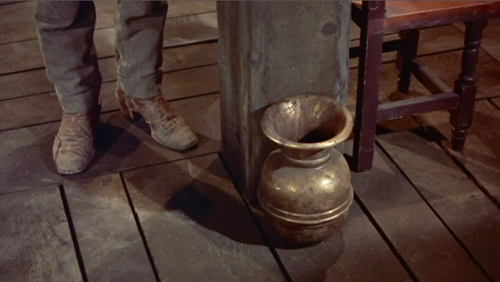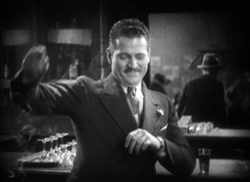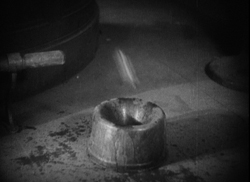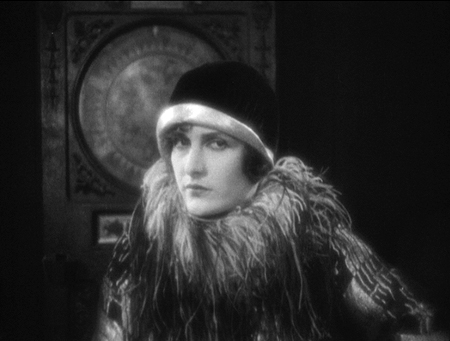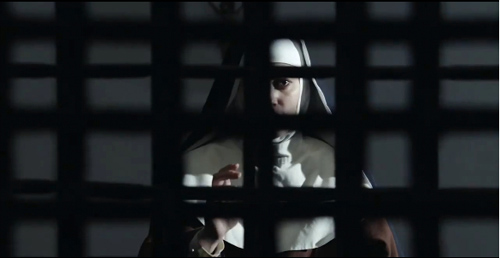Archive for the 'Film criticism' Category
Octave’s hop: Andrew Sarris
La Règle du jeu (The Rules of the Game, 1939).
DB here:
The death of Andrew Sarris last week isn’t just a saddening moment for those of us who admire exhilarating film criticism. It also reminds us how much American culture can owe to a single person.
Everyone who writes about Sarris writes about how they came to know his work. It was that powerful, and if it hit you young, you were never the same. (You never hear about the sixty-year-old who suddenly becomes an auteurist.) The period of his greatest impact was the 1960s-1970s when, to borrow a phrase from Dave Kehr, movies mattered. But his influence has lingered, powerfully, a lot longer.
I think that the best way to honor Sarris is to take his ideas–not just his opinions, but his ideas–seriously, so that’s what I’ve tried to do in this tribute. First, though, some comments that are obligatory in any discussion of Sarris.
Obligatory autobiography 1
1963: When I was sixteen I wrote to various film magazines and asked for sample issues as a “prospective subscriber.” Surprisingly, several answered, and I amassed a few copies of Film Quarterly, Films and Filming, and Movie. No gift from the land of film journals was more propitious than that fateful issue 28 of Film Culture entitled “American Directors.” It was the first draft of what would become Sarris’ 1968 book, The American Cinema.
Issue 28 was a dangerous item to give a kid. It contained what Georgie Minafer calls “touchy chemicals.” At first I was baffled. There were those famous categories: How to distinguish “Lightly Likeable” from “Less Than Meets the Eye”? Who were Budd Boetticher, Tay Garnett, and John M. Stahl? What did it mean to say that Robert Montgomery “executed a charming champ-contre-champ joke in Once More, My Darling”? To me it was all Expressive Esoterica. Here was a cave of mysteries, but it hinted at treasures.
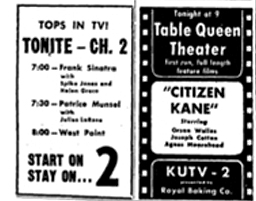 Sarris’s filmographies were packed with titles I’d never heard of. How could I catch up? Around 1955, the studios had begun selling their pre-1948 titles to local television stations. By the next year, people living in major cities could tune in five or six movies a day. At the forefront of TV sales was the financially precarious RKO, which sold over seven hundred titles to an outfit called C & C. C & C packaged the library as 16mm TV prints under the rubric of “Movietime.”
Sarris’s filmographies were packed with titles I’d never heard of. How could I catch up? Around 1955, the studios had begun selling their pre-1948 titles to local television stations. By the next year, people living in major cities could tune in five or six movies a day. At the forefront of TV sales was the financially precarious RKO, which sold over seven hundred titles to an outfit called C & C. C & C packaged the library as 16mm TV prints under the rubric of “Movietime.”
Auteurism owes a good deal to the 1950s-1960s equivalent of home video, the thousands of 16mm prints floating around local TV stations. In Manhattan, WOR-TV screened their films under the rubric “Million Dollar Movie.” The same film might run once or twice every night for a week (and twice or more on weekends). Without benefit of WOR or New York’s revival houses, I was still able to use Rochester television to sample some of the titles that Sarris had listed, especially those given in big caps. (Italicizing must-see items didn’t show up until the book version.) Sarris’s essay, “Citizen Kane: The American Baroque,” was published in Film Culture in 1956, the same year that the RKO library began to be syndicated and Kane was reissued in theatres around the country.
I did wind up subscribing to Film Culture. It was the least I could do to pay them back.
Obligatory autobiography 2
Fall 1965: At a state college up the Hudson, the English department hosted a debate on contemporary American movies. The adversaries were Pauline Kael and Andrew Sarris, both just coming into the national spotlight. One freshman came early and sat with comic earnestness in the front row, a spot he would fetishize later.
Kael was witty and acerbic, tossing off judgments with a wave of her cigarette holder. The Cincinnati Kid was the best of the current crop; Jewison showed great promise. She was riding high because I Lost It at the Movies had come out that spring and was greeted with hosannas. The New Yorker review contrasted her with “the far-out Sarris.”
He didn’t look so far-out. In a crumpled suit, he was resolutely uncharismatic, looking mildly unhappy to be dragged blinking out of the Thalia and shipped upstate. He talked fast, interrupted himself, and, finding few recent movies to praise, celebrated Max Ophuls and Jean Renoir. He delivered enigmatic observations like, “All movies should probably be in color.”
At evening’s end, I knew which camp I belonged in. I got an appropriately nerdy autograph for my Film Culture issue: “Cinecerely yours, Andrew Sarris.” More important, I exulted in a sense that my almost grim obsession with movies had been validated. Not for some time would I realize that I had enlisted, to put it melodramatically, in a fight for American film culture. The battle lines were drawn more sharply in Manhattan than in Albany, but everywhere one thing was clear. Kael was clearly the standard bearer for them, and Sarris was ours.
Obligatory comparison: S vs. K
Who were the them? They were the hip intellectuals who enjoyed a night at the movies. At faculty parties throughout the 1970s I had to check myself when professors of lit or law asked me if I didn’t find Kael’s review that week intoxicating. And she writes so well! As chief New Yorker critic, Kael became the grand tastemaker, a person even filmmakers courted. But who would try to curry favor with the guy who wrote for the Village Voice? It reminds you of the joke about the starlet so dumb she slept with the screenwriter.
Of course like all acolytes we overplayed the differences. Both Kael and Sarris loved classic studio cinema, the performers and scripts as much as the directorial handling. Both critics bemoaned Soviet montage and what they saw as its descendant, the overbusy technique of the 1960s. Both deplored stylistic aggressiveness (the Tony Richardson Syndrome) and both idolized Renoir. Both loved lyricism.
According to us, though, Kael wrote for those who dug movies, while Sarris wrote for those who loved cinema—the medium itself, or rather an exalted idea of the medium’s potential, an ideal form of expression at once dramatic, poetic, pictorial, and musical. He saw each film as bearing witness to the promise of what cinema might be, and he looked in even the tawdriest products for something approximating his dreams. Despite his enthusiasms, he tried for detachment, viewing the latest movie from some unpredictable historical perspective.
Kael famously declared that she watched a new film only once, because that was the way her readers would consume it. But who, we thought, would want to write about a movie after seeing it only once? Mightn’t it reveal some strengths or weaknesses on a second viewing? If it was a good movie, who wouldn’t want to see it more than once? In that same freshman semester, when there were still first-run double features, I sat through The Glory Guys twice in order to watch Help! three times. And that wasn’t even a particularly good movie.
Kael pounced on faults, Sarris savored beauties. Kael made each weak film seem like a blow to her intelligence. Sarris, although he could be harsh, tended to forgive. He taught that it was better to leave a door open than to write someone off—even Bergman, whom some of us would never learn to like until Persona, some not until Fanny and Alexander. Sarris subordinated his personality to that of the movie and its director, which made him seem less fiery than his uptown counterpart; but his attitude suited our own somewhat adolescent amorphousness of character. The arrogant certainty of our tastes was, paradoxically, born of a passionate humility, a sense of serving wise masters named Dreyer, Murnau, Mizoguchi.
Rethinking film history
Sarris is known primarily as the man who gave us the American version of auteurism, or what he called “the auteur theory.” It wasn’t a theory of cinema as such, but rather a heuristic approach to criticism: tips on what to think about and look for when you wanted to plumb a movie’s artistry. But initially, auteurism claimed to be a theory of something else. The opening chapter of The American Cinema is called “Toward a Theory of Film History.”
In Sarris’s day, most people writing about the history of film as an art accepted a notion of technical progress. According to this view, filmmakers became significant by contributing toward the development of the medium. Editing emerged through the efforts of Méliès, Porter, and Griffith, followed by the Russian Montage directors. Various national schools revealed more possibilities of the medium: fantasy and abstraction with the German Expressionists, derangement of sense with the Surrealists.
When sound arrived, a few directors (Clair, Mamoulian, Hitchcock) explored the stylized possibilities of that new technology. But many historians, considering that cinema was inherently a visual medium, declared sound an unwanted intrusion. Clearly, the great days of cinematic artistry were over. Most synoptic histories of the period fell silent about the evolution of technique after the 1920s and concentrate on the emergence of certain genres, such as the musical and the film of social comment.
Even André Bazin could be said to accept the premises of step-by-step artistic progress. Bazin showed that sound cinema wasn’t a dead end, that new artistic possibilities were exploited in the 1930s and 1940s. These were mostly creative alternatives to editing-based technique: the long take, extended camera movement, deep-space staging, and deep-focus cinematography. Bazin claimed that these techniques were most fully on display in the works of Renoir, Wyler, Welles, and some Neorealists.
Sarris was deeply influenced by Bazin’s ideas, but he didn’t accept the conception of film history as an accumulated technical evolution. Sarris called this the “pyramid fallacy,” with each filmmaker adding his slab to the rising and narrowing edifice of cinema. Instead, he proposed thinking of film history as an inverted pyramid, “opening outward to accommodate the unpredictable range and diversity of individual directors.”
In practice this demands that the historian survey entire careers, especially the works of ripe old age. It demands that the historian plot directors’ creative trajectories as paralleling and intersecting and overlapping—perhaps coalescing into broader trends, perhaps creating dead ends. The cinematic universe expands with each new film made, every old film rediscovered or simply re-seen. Auteurism “places a premium on having seen every work by a director who is deemed worthy of a study in depth; and by the time all the cross-references have been pursued in every possible direction auteurism seems to insist that every film ever made is relevant to the inquiry.”
Film history becomes less a linear progress toward something than a vast network of affinities and differences. This idea naturally led Sarris the writer not to the mammoth survey but to multifaceted essay collections. His big book, “You Ain’t Heard Nothin’ Yet,” looks like a panoramic history but is in fact a free-range miscellany, a sort of unbuttoned late-career redo of that Film Culture issue..
You can argue that Sarris was proposing a non-historical history, one that dispenses with concepts of influence and cause and that pulverizes any coherent narrative. That seems to me a valid objection. Despite its claim to be a theory of film history, Sarris’s auteurism strikes me as a historically informed approach to film criticism. The ultimate aim isn’t a convincing historical narrative but a compelling aesthetic judgment. Sarris’s idea of expanding filiation, infinite comparison and contrast, allows him to pursue what matters: evaluation.
In this respect at least, he’s agreeing with his predecessors, the writers who saw history as linear progress. But his criteria of value are different. For the traditionalists, the filmmakers who grasped the next step that the medium should take in its creative development become the best. For Sarris, the best filmmakers used the resources at their disposal to create valuable works that also displayed a distinct conception of human life. “Griffith, Murnau, and Eisenstein had different visions of the world, and their technical ‘contributions’ can never be divorced from their personalities.” Innovation was secondary to expression, and expression could best be gauged by tracking the wayward currents of the history of film style.
Auteur, yes; but of what?
New York Film Festival 1966: Pier Paolo Pasolini, translator, Andrew Sarris, and Agnes Varda. Photo by Elliott Landy. From Film Culture no. 42 (Fall 1966).
The auteur “theory” creates a decentralized and dispersed conception of film history—not a tree with a solid trunk and clear-cut branches but a bristling, tangled bush. The historian will dissolve big changes and broad trends into the doings of particular film artists. Who are these artists? Well, obviously, directors.
This move shouldn’t have been controversial. Critics had long assigned primary creative responsibility to directors. In the 1910s Louis Delluc heaped praise on DeMille and Sjöström, while Griffith was acknowledged around the world as a great innovator. Later von Stroheim, von Sternberg, Eisenstein, Pabst, Clair, Welles, Hitchcock, Maya Deren, and many other filmmakers were recognized as the artistic authority behind their work. In the early 1950s, foreign-language filmmakers such as Kurosawa and Bergman were identified (and even promoted by their distributors) as all-powerful creators saying something through their art.
Sarris’s real innovation was, along with the critics around Cahiers du cinéma and Movie, to transfer the idea of the expressive film artist from the headier regions of art cinema to the jostling, compromised world of Hollywood. There were obvious objections.
*Filmmaking is a “collaborative” activity, so you can’t attribute the final work to a single hand.
Yet in the collaborative medium of opera we speak of a Zeffirelli production as opposed to a Peter Sellars one. Why can’t a film director be a synthesizing artist orchestrating the contributions of many other artists?
*But in opera and other theatre forms, you have a preexisting text, the script or libretto or score. Why isn’t the screenwriter the artist, as Shakespeare or Verdi is?
Because theatrical texts are designed to be instantiated on different occasions, while film scripts are written to be produced only once. The film’s final form includes elements of the script, but that final form, being cinematic, can’t be uniquely specified in verbal language. As we all realize, give the same screenplay to six filmmakers, and you get six different and equally free-standing films.
*Popular film can’t be compared to high art. Artistry demands control, and the novelist, the painter, and even the opera director will exercise complete control over the final work. A Bergman or Antonioni has the cultural clout to dictate every aesthetic effect, but the Hollywood filmmaker works as part of a larger process controlled by others. He is handed a script and shoots it, and not necessarily all of it; second-unit and visual effects staff have their input too. The producer may demand more close-ups. In the classic studio system, the director wouldn’t typically get final cut; the producer would shape the released film. All these conditions constitute barriers to artistic expression. The auteur theory, when applied to Hollywood, is deeply inappropriate.
One answer to this objection is that many directors, including some of the best ones, did have a good deal of control over their work: Hitchcock, Hawks, and others were their own producers and worked on their scripts and oversaw their post-production. Moreover, a director can control choices down the line in sneaky ways, as when Ford shot his films so that they could be assembled in only one way.
Sarris advanced another reply to the control objection. If it owed something to the Cahiers young critics, he articulated and practiced it more keenly than they. He proposed a critical method: Take as many films signed by the director as you can find. Attend to the way they exercise their craft, the way they tell their stories and convey their meanings. Seek out an expressive core that seems distinctive, even unique.
Most directors’ collected works won’t yield this. “Not all directors are auteurs. Indeed, most directors are virtually anonymous.” Only the best directors will display a distinct expressive quality. Hawks and Hitchcock evoke radically different worlds of action and feeling, just as Mozart and Rembrandt can.
Fifteen years after his initial statement on the matter, “Notes on the Auteur Theory in 1962,” Sarris suggested that the elusive concept of personality was not to be derived from the director’s biography. “I was never all that interested in the clinical ‘personalities’ of directors. . . . A director’s formal utterances (his films) tell us more about his artistic personality than do his informal utterances (his conversation).”
For example, we understand John Ford’s respect for what Sarris calls “codes of conduct” not through the old curmudgeon’s interviews but by confronting the tangible texture of the movies. One of Sarris’s favorite examples occurs in The Searchers. Drinking his coffee, the Ward Bond character glances toward the wife of the household. Then his point of view reveals her stroking the uniform of her husband’s brother, played by John Wayne.
Cut back to Bond as the wife and her brother-in-law meet for a tender farewell. Bond stares off into space, chewing.
“Nothing on earth,” writes Sarris, “would ever force this man to reveal what he had seen. There is a deep, subtle chivalry at work here, and in most of Ford’s films, but it is never obtrusive enough to interfere with the flow of the narrative.” The economy is part of the point. “If it had taken him any longer than three shots and a few seconds to establish this insight into the Bond character, the point would not be worth making.”
In the Hollywood studio context, there was something heroic about the rare director who could surmount all the pressures, filter out all the noise, and shape the impact of his work. “The auteur theory values the personality of the director precisely because of the barriers to its expression.” Like a great Renaissance painter paid by a pope or a duke and pledged to illustrate well-known stories, the Hollywood director working for a studio could occasionally conjure up something powerful and distinctive.
Auteurism, Sarris claimed, is our straightest road to determining a film’s value. The great films, by and large, will be those that evoke distinctive directorial sensibilities. But “by and large” allows for the possibility of excellent movies that we can attribute to other forces—script, stars, source material, the happy intersection of talents. Casablanca, writes Sarris, “is the most decisive exception to the auteur theory.” Sarris loved movies more than he loved his theories.
Compare, contrast, repeat
Sarris’s breakthrough essay, “Citizen Kane: The American Baroque,” appeared in Film Culture during the 1956 revivals of the film. This detailed explication, published when Sarris was twenty-eight, betrays his grad-school training at a period when the New Criticism reigned. In a single stroke, he pioneered the sort of close reading that would become central to Anglo-American academic film criticism.
I can’t recall any later Sarris essay offering such an intensive analysis of a single film. As he developed his historically-guided critical appraisals, he favored synoptic appreciations of directorial careers. These became the occasions for him to point out interacting directorial personalities that comprise that vast network of cinema.
Instead of macro-analysis, Sarris embraced a strategy of “drilling down,” we’d now say, to a single revelatory passage. The chief tactic is comparison, often involving two directors faced with a comparable situation. Both City Lights and The Goat show a protagonist hiding on a statue about to be unveiled. Chaplin seizes the chance to deflate the ceremony.
But Keaton, says Sarris, is less interested in satire; he is “a pessimist in perpetual motion.” In The Goat, “Keaton remains mounted on the clay horse until it begins to sag and crumple under his weight, and the sculptor, a bearded nincompoop in a beret, proceeds to break down and weep.”
“Keaton’s expression here,” Sarris claims, “is mercilessly pragmatic. What good is a clay horse (art?) if you can’t mount it to your own advantage? There is something unabashedly ruthless about Keaton’s comedy, which chills his humor.” This was the period when critics, having just rediscovered Keaton’s films, claimed him as a “metaphysician.” Sarris likened him to Beckett.
Sarris wasn’t alone in turning to detailed commentary at the period; we had Dwight Macdonald’s appreciative 1964 essay on 8 ½ and John Simon’s book-length study of Bergman (1973). But Sarris got there early with the Kane piece, and throughout his career he used analysis to pinpoint authorial personality. Attention to nuanced differences allowed him to create a kind of connoisseurship.
The ultimate expression of this connoisseurship emerges in his concern for privileged moments. A critic has to be alert for shots or gestures or lines of dialogue that encapsulate the emotional tenor of a film and a director’s sensibility. Sarris’ example is a moment in La règle du jeu:
Renoir gallops up the stairs, stops in hoplike uncertainty when his name is called by a coquettish maid, and then, with marvelous post-reflex continuity, resumes his bearishly shambling journey to the heroine’s boudoir.
If I could describe the musical grace note of that momentary suspension, and I can’t, I might be able to provide a more precise definition of the auteur theory. As it is, all I can do is point at the specific beauties of interior meaning on the screen and later catalogue the moments of recognition.
No director but Renoir, Sarris suggests, would have Octave break the scene’s rhythm in exactly this way–and in a manner, Sarris’s bear-metaphor hints, that anticipates Octave’s costume for the climactic party in the chateau. The nonchalant, slightly awkward interruption epitomizes Renoir’s entire style of filmmaking, which has room for casual deflections from neat plotting and groomed performances. The critic’s words can’t wholly capture the force of Octave’s hop, and its resonance for Renoir’s film and his oeuvre. It is, says Sarris, “imbedded in the stuff of cinema.”
Both cinephiles and ordinary viewers are seized by luminous instants that change our skin temperature. We come out of a film satisfied if a few epiphanies have flashed upon us. The critic can signal them but not explain them fully. Interior meaning is the product of craft and personality, but it can’t be reduced to them. It creates a tingling, fugitive beauty that is unique to cinema.
Everyone has his or her own Sarris. The foregoing offers merely bits of mine, and they’re largely academic in slant. That’s because I think that Sarris changed, among other things, the way film history and criticism were taught in American universities. While Kael influenced film journalism, particularly in the upscale markets, Sarris’s legacy is best seen in cinephile criticism (Film Comment, Film Quarterly et al.) and academic film studies. Some Paulettes went to work for the New York cultural weeklies, high and low. Many people who were Sarrisites to some degree (Jeanine Basinger, James Naremore, John Belton, William Paul, Elisabeth Weis, Chuck Wolfe, Mark Langer, Robert Lang, et al.) became professors. Kael’s followers turned out essays, but Sarrisites like Todd McCarthy and Joseph McBride wrote books based firmly in research. Sarris’s version of auteurism has been reworked, in plenty of intriguing ways, in directorial monographs from university presses. He once remarked ruefully that he was an academic among journalists and a journalist among academics, but he managed to bridge the gap adroitly.
Sarris was too far-out for the New Yorker in 1965, and probably for the New Yorker of today. But history, and not just the history of movies, was on his side.
Sarris’ life and death have called forth many eloquent tributes. Among the best are Kent Jones’ career overview, Richard Corliss’s moving memoir, and Jim Emerson’s calm discussion of the excesses of the Sarris vs. Kael dichotomy. See also Ben Kenigsberg’s memories of Sarris’s teaching style.
My quotations are taken from Film Culture no. 28 (Spring 1963), The American Cinema (Dutton, 1968), Confessions of a Cultist: On the Cinema, 1955/1969 (Simon and Schuster, 1971), The Primal Screen (Simon & Schuster, 1973), and The John Ford Movie Mystery (Secker & Warburg, 1976). Thanks also to email conversations with John Belton of Rutgers and Dennis Bingham of Indiana University.
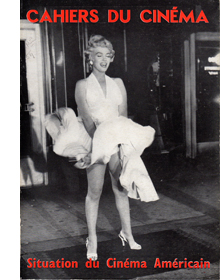 When I received Film Culture no. 28, I didn’t know that it represented a continuation of a Cahiers du cinéma tradition. In December 1955, the journal had published a special issue, “Situation du Cinéma Américain” (no. 54). It included not only critical essays but a “dictionary” of contemporary American directors: small-print filmographies followed by a paragraph of lapidary commentary. (“Lang’s work is founded on a metaphysics of architecture.”) Later issues devoted “dictionaries” to current French cinema (no. 71, May 1957), the Nouvelle Vague (no. 138, December 1962), and more recent American cinema (no. 150-151, December 1963-January 1964). In his American Cinema project, Sarris altered the format significantly by expanding the commentaries into essays and then grouping directors within sharp-edged, highly memorable categories of value. In turn, Sarris’s catalogue seems to have been the model for Martin Scorsese’s “Personal Journey through American Movies.” In the same tradition is Jean-Pierre Coursodon and Pierre Sauvage’s too-little-known American Directors (1983).
When I received Film Culture no. 28, I didn’t know that it represented a continuation of a Cahiers du cinéma tradition. In December 1955, the journal had published a special issue, “Situation du Cinéma Américain” (no. 54). It included not only critical essays but a “dictionary” of contemporary American directors: small-print filmographies followed by a paragraph of lapidary commentary. (“Lang’s work is founded on a metaphysics of architecture.”) Later issues devoted “dictionaries” to current French cinema (no. 71, May 1957), the Nouvelle Vague (no. 138, December 1962), and more recent American cinema (no. 150-151, December 1963-January 1964). In his American Cinema project, Sarris altered the format significantly by expanding the commentaries into essays and then grouping directors within sharp-edged, highly memorable categories of value. In turn, Sarris’s catalogue seems to have been the model for Martin Scorsese’s “Personal Journey through American Movies.” In the same tradition is Jean-Pierre Coursodon and Pierre Sauvage’s too-little-known American Directors (1983).
For more on C & C, which was a soda-pop company, go here. By 1956, WOR-TV was owned by the same company that owned RKO, so it’s no surprise that Kane, King Kong, and other items from the Movietime package played ceaselessly on that station. WOR’s radio station intersected my life from another angle.
For more on the standard version of the history of film art, along with Bazin’s revision of it, see my On the History of Film Style.
The homage volume, Citizen Sarris: American Film Critic, includes many fine pieces, but please don’t read my contribution. Editorial carelessness has mangled it beyond recognition. The version I’ll stand by, “Cinecerity,” is available in my Poetics of Cinema. Portions of this blog entry are lifted from that essay, but I’ve omitted most of my discussion of Sarris’s conception of film style.
New York Film Festival, 1966: Nat Hentoff, Pauline Kael, Parker Tyler, Arthur Knight, Judith Crist, Hollis Alpert, Andrew Sarris. Photo by Elliott Landy. From Film Culture no. 42 (Fall 1966).
PS 24 June 2012: More moving commentary in memoriam at the Film Comment site.
The Tao of RIO BRAVO; or, A Yakky Way of Knowledge
Too long has this scrolling site ignored the Sacred Text. In a gesture of penance, I return to the true path. Like all Sacred Texts, this one attracts worshippers in different degrees: the Seekers, the Initiates, the Adepts, and the Exegetes. There are Heretics too. Today, I wish merely to introduce you, who may not yet be even a Seeker, to the serenity of The Way.
The Word, in plenty
Seekers who have become Initiates agree: Their blinding moment of conversion came when they realized that the words of the Sacred Text speak to all times, all places.
Other Sacred Texts dispense a few trinkets of wisdom (“I have a bad feeling about this.” “We’re gonna need a bigger boat.” “Show me the money.”) These are tag lines, sound bites, not poetic glimpses of glory. Uniquely and universally, passages in our Text raise the spirit and cast out doubt and despair. But far from being otherworldly, they carry practical wisdom and illuminate every situation. What crisis in your life, brother or sister, would not be piercingly clarified if you were able to utter one of these lines?
It’s nice to see a smart kid for a change.
I’d say he’s so good he doesn’t feel he has to prove it.
That’s what I’d do if I were the kind of girl you think I am.
Sorry don’t get it done, Dude.
You look a little used.
Aw, I’m not gonna hurt him.
If I’m gonna get shot at, I might as well get paid for it.
Let’s take a turn around the town.
I’m glad we tried it a second time. It’s better when two people do it.
Borachone talking big.
You’d better go easy on that stuff.
Don’t set yourself up as being so special. You’d think you invented the hangover.
Aw, hell, what’s the difference? We’d all be dead by then.
Nobody’s run in here./ We’ll remember you said that.
Found yourself another knot-head who don’t know when he’s well off?
A game-legged old man and a drunk. That’s all you got?/ It’s what I’ve got.
Think you’re good enough?
Is he as good as I used to be?/ It’d be pretty close. I’d hate to have to live on the difference.
To become an Initiate, the Seeker must commit these to memory and meditate upon them intently. An Adept will be able to summon them up, half-consciously, in a range of situations–the more far-fetched, the more enlightening. One will always be appropriate.
The Name
Exegetes have pointed out that the figures of light in the Sacred Text do not have the usual names. They are, emblematically, called Stumpy, Dude (aka Borachone), Colorado, Feathers. He Who Is Called Chance is named John T., but even the middle initial is turned into an epithet (“T for Trouble”).
Far from being an accident, the names in the Sacred Text are there to impel the Initate into deeper mysteries. Is, for instance, Stumpy The Elder called Stumpy because of his lameness—always a sign of grace in sacred texts? Because of his inertness (as stiff as a stump)? Or because a tree, even though harvested, retains its attachment to the earth by remaining rooted? Perhaps He Who Is Called Stumpy is “grounded,” as the current saying has it.
The Text is figural, both metonymic and metaphoric. Young Colorado is son of Rocky Ryan from Denver. He Who Is Called Wheeler is a man of wagons. She Who Is Called Feathers wears feathered clothes, but also has a teasing lightness of manner. He Who Is Called Dude constitutes a crux. Is he a “dude,” an Easterner who has come west, or is he a dude because he favors fancy outfits? (See “Raiment,” below.)
The central fact is that in this text, the mystery of naming opens on to the Mystery of Being. Everyone is named something, but many are not named by their name.
Raiment
Once the devout Seeker has sensed the limitless depths of the The Words, the more inquisitive will turn to the images. In the opening scene of the Sacred Text, a largely wordless series of encounters in barrooms, a world is created before our eyes. It is a world of debasement, treachery, and sudden death. A contemporary text called Variety, secular but still enlightening, notes: “…gets off to one of the fastest slam-bang openings on record.”
Exegetes have long praised this eloquent passage. They note that a text so replete with Words benefits from an extended passage of muteness. Not silence, for the almost continuous music attributed to Dmitri Tiomkin provides its own wordless “commentary” on the action. This sordid, barbarous world will be redeemed; those who are left low on the saloon floor will rise three days afterward (note!) to triumph.
Serious study of the Text’s images drives the Adept to note the raiment in which the figures are clothed. The Nemesis Joe Burdette wears a bright cowhide vest, suggesting his animalistic anima. He Who Is Called Dude begins in dirty garments, earns the right to garb himself in splendor, but through weakness of soul he is once more soiled.
She Who Is Called Feathers manifests the most dazzling changes in raiment.
Hers receive commentary within the Text, while the garments of He Who Is Called Chance are noticed only by her.
Those things have big possibilities, but not for you.
Hey, Sheriff, you forgot your pants.
But these may be interpolations by later hands.
Disputed passages
Like all Sacred Texts, this contains stretches that excite puzzled commentary. What, in the opening scene, is Wheeler supposed to “tell his men”? Why so many flying insects at night? Why is He Who Is Called Chance once, and only once, seen awkwardly grappling with his rifle, trying to hold it while he shrugs into his jacket?
There is the curious verbal slippage in the song sung by He Who Is Called Dude. He sings of “My three good companions—my rifle, pony, and me.” To the heathen mind, this is a flagrant error. You can have a rifle and a pony as a companion, but you can’t have you as your companion. Can you?
To doubt the Sacred Text at this point is to underestimate the subtlety of the Authors. Recall that the tale told by the song is a dream (“It’s time for a cowboy to dream“). As in other venerable texts (e.g., Bible, Ramayana), dreams are to be taken as warnings, prophecies, or hints as to the true meaning of the story. And so it proves here. We know that He Who Is Called Dude is a divided man: Borachone and pistolero, drunk and deputy. The singer, as we’ve seen, has an untamed side that bursts out into violence against nearly everyone, including his Savior, He Who Is Called Chance.
Hence the split identity of the rider in the song. He is a me, but he also has a me. And around the bend, waiting for both of them, is another divided figure, a woman called “my sweetheart darling.”
There are Exegetes who would see in this passage the source of another worthy text, Western Redundancy Playhouse Theatre, but exploring that would take us too far afield.
More obvious is the Text’s great cosmic sign: The sun rises and sets on the same horizon.
No further proof is needed of the miraculous nature of this narrative.
Heresies
I do not refer to callow efforts to dishonor the Text (e.g., “I think we need a few more scenes in the jail”). Instead, I mention simply the most important efforts by believers, often Adepts, to sow petty doubts. There is, for instance, the efforts to replace the canonical status of this Text by later, more derivative ones (El Dorado; Rio Lobo). Uneven and fragmentary, they have never achieved widespread recognition of Sacredness. Other heresies claim our text itself is derivative, and one offers the biggest challenge to the devout.
I refer of course to the Heresy of the Spittoon.
In the Genesis section already mentioned, Nemesis Burdette flips a coin into a spittoon, and He Who Is Called Dude, needing to buy drink, stoops to retrieve it from the rancid vessel.
Only the intervention of He Who Is Called Chance saves He Who Is Called Dude from this act of degradation. This passage has a parallel later in the Text, when another nemesis must fish a coin out of a spittoon.
The reversal in power is also a step in the redemption of He Who Is Called Dude.
But Adepts have noticed that in Decision at Sundown, a text attributed to one Budd Boetticher and dated 1957 (the Sacred Text we have is dated 1959), a sheriff refuses to accept the money of the protagonist and drops the coins into a spittoon.
Consider another passage in another Boetticher-signed text of the era, Buchanan Rides Alone (confirmed to be from 1958). Here the protagonist, prosaically named Buchanan, disarms a young gunslinger and drops the boy’s bullets into a spittoon.
The vessel, offscreen below frame, announces its presence by the tinkling sound made by the falling rounds.
Heretics have hinted at plagiarism, especially in the light of a reference in another text of the period, Ride Lonesome (dated February 1959, two months before the appearance of our Sacred Text). Here a nemesis tells of a poster “gun-tacked to every tree and stump (!) between here and Rio Bravo.”
While undeniably puzzling, these correspondences do not point to plagiarism. There may have been an earlier, Ur-version of our Sacred text, that has simply not survived. In moments like these we must put our faith in the Authors.
Recurring formulae
Finally, we must return to the Word. Seeker, Initiate, Adept, Exegete: All acknowledge the Text’s verbal echoes. As with Homer’s wine-dark sea and Vergil’s pious Aeneas, formulaic tags recur in our tale, but with more variation than in classic texts.
Our first business is business.
We have important business …. Me and my friend we make our business alone.
I’ll tell you what I’m a lot better at, Mr. Wheeler. That’s minding my own business.
I figure why is not my business./ You’ve got peculiar ways of choosing what is your business.
You think I’ll ever get to be sheriff?/ Not unless you mind your own business.
As if to signal to the devout the importance of every word, the Text provides its own meta-commentary. As a French exegete has said: “Discourse cleansing discourse, backchat ruling over chatter and chitchat.”
I’ll go outside so you can talk more freely.
I guess I talk too much.
He’ll keep talking till we get out of here.
Can’t you talk plainer than that?
Young Colorado says that Nemesis Nathan Burdett is “talking now” through the Deguelo tune./ I guess we made him talk after all.
Me, I just talk all the time./ You most certainly do./ You’ll get used to that. You’ll have to. Either that, or start talking to me.
Now I’m running out of breath. You talk if you want to.
Like all Sacred Texts, for all this talk of talk, this one knows that the ultimate truth lies beyond words.
Just stop talking. Just let it be.
Good advice.
Before I followed the Way, the spittoon was a spittoon. As I began to learn the Way, the spittoon was more than a spittoon. When I had learned the way, the spittoon was once again a spittoon.
Addendum 15 April 2012: This humble guide to the Text has aroused further passion among Exegetes. Three have pressed even more fiercely the Heresy of the Spittoon, claiming that it derives from a much more ancient text than the Boetticher-attributed ones mentioned above.
Antonio of the Red Palace writes:
Regarding the scene involving the spittoon, I think it’s a shout-out to another one from Sternberg’s Underworld. You know, that one involving an equally “Borachone” character (Rolls Royce Wensel) being humiliated by “Buck” Mulligan. Interestingly, the “hero” (in this case Bull Weed) stands for the weak one.
Even in both films, the female character is called Feathers. ¿ Coincidence?
The Exegete declares a heartening willingness to believe, as all Seekers must, that There are no coincidences. From David Cairns, Sifu of Shadowplay, Exegete Extraordinaire of many other texts, comes further observations:
Like Antonio of the Red Palace, Shadowplay Sifu displays admirable historical awareness and interpretive ingenuity. But there is still room for disputation about sources and the path of influence. Here is Lea Jacobs of the School of the Badger to open another avenue:
The earliest version of the coin in the spittoon that I know is Underworld. Charles Furthman, brother of Jules [scribe who co-penned Rio Bravo], worked on the adaptation [of Underworld]. So I have always assumed the bit was “in the family.”
It is a measure of the spiritual power of the Sacred Text that it so stirs the imagination of the devout. And in truth, this scrolling blog’s little guide should have pointed out the strongest evidence for the Spittoon heresy (as well as the philological question of “Feathers”). These Exegetes are hereby thanked for extending the already vast commentary on the Text. But let us remember that the earlier text in question is regarded by many Adepts as itself derivative.
In Underworld, the nemesis who flings a ten-dollar bill into the spittoon is called “Buck” Mulligan–a transparent trace of literary lineage. For what readers text do not recognize the reference?
Stately, plump Buck Mulligan came from the stairhead, bearing a bowl of lather on which a mirror and a razor lay crossed.
Let us not forget that this literary “Buck Mulligan” has the proper first name Malachi, usually translated as “God’s messenger.” This surely changes our understanding of the blowhard who mockingly offers the ten-dollar bill to Rolls Royce; for he starts Rolls Royce on his path toward sobriety and self-respect.
For such reasons, Ulysses is most fruitfully read as a gloss on Underworld.
Nonetheless, consultation with wiser heads than this chronicler’s yields a change in the Canon. Henceforth the Heresy of the Spittoon will be known as the Cuspidor Crux.
Addendum 21 April 2012: Another Adept, Simone Starace, has disclosed more evidence for the Cuspidor Crux. She points to a passage in the secondary writ, Joseph McBride, Hawks on Hawks (1982), p. 131:
JMB: There are several things in Rio Bravo that are similar to Underworld, which you and Furthman also helped write.
HH: I stole two things, the dollar in the spittoon and the girl’s name, Feathers.
Simone adds that on page 159, according to McBride’s filmography: “Hawks claimed to have contributed to the script of Underworld.” The palimpsest thickens.
The 50-50-50 split
Independencia (Raya Martin, 2009); set photo by Alexis Tioseco. Our comment here.
DB here:
I received the newest Cinema Scope after we had posted our book roundup last week. Awkward timing, but I can still alert you to this splendid effort. In the tradition of Cahiers du cinema (every film magazine wants to be Cahiers), this enterprising Canadian journal has celebrated a benchmark issue with a compendium–issue 50 devoted to 50 filmmakers (all under 50).
It’s a gimmick, but a good one, and of ancient lineage. Cahiers and other French journals established an admirable tradition of obsessively gathering brief entries on filmmakers under a thematic rubric. (The organizing principle: alphabetical order.) In this contribution to the tradition, Mark Peranson, Andrew Tracy, and the rest of the Cinema Scope équipe have outdone themselves.
We get, of course, critics aplenty, and they offer short, sharp takes: Kent Jones on Maren Ade, Scott Foundas on Wes Anderson, Andrea Picard on Liu Jiayin, Shelly Kraicer on Pema Tseden, Chuck Stephens on Apichatpong Weerasethakul, and many more admirable matchups.
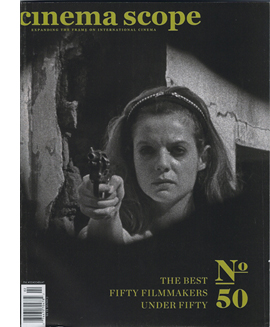 This sort of thumbnail catalogue works best when encapsulation is kept to the scale of American menu squibs, or even fortune-cookie apothegms. The phrases don’t have time to turn gently, so they careen. Tony Rayns on Jia Zhangke:
This sort of thumbnail catalogue works best when encapsulation is kept to the scale of American menu squibs, or even fortune-cookie apothegms. The phrases don’t have time to turn gently, so they careen. Tony Rayns on Jia Zhangke:
With a sensibility pitched at the exact mid-point between Robert Bresson and Arthur Freed….
Christoph Huber on Paul W. S. Anderson:
Brit-born Paul W. S. is the elder, least pretentious, and most consistently amusing Anderson of the current director trifecta: its termite artisan.
Michael Koresky on Kore-eda Hirokazu:
He’s at his best when there’s the least mess.
It’s not all praise, either. Adam Nayman contributes a vinegar-doused write-up of Paul Thomas Anderson, although he likes one cut in There Will Be Blood. Alex Ross Perry finds that Fincher’s latest work is uninspiring, but at least now “he can screw around all he wants.”
As if this weren’t enough, filmmakers (another Cahiers tradition) add their voices, and images, to the chorus. So there are Weerasethakul on Lucrecia Martel, Ben Rivers on Bertrand Bonello, James Benning on Sharon Lockhart, and Albert Serra on Zhao Liang, among others.
One purpose of such a Baedeker’s is to alert you to new work. I counted a dozen directors I hadn’t heard of, and another four or five whose films I hadn’t seen. But this kind of enterprise has long-range impact too, especially right now. Cinema Scope 50-50-50 is a bracing psychic antidote to the usual complaints about today’s empty, worthless cinema, and its inferiority to the dazzlement on view on HBO and AMC. For a recent example of this litany, see Wolcott, who yearns for the days of An Unmarried Woman. Projects like the Cinema Scope celebration lift your eyes to the horizon. You can start to believe in cinema’s future.
Are these directors marginal? Not really. The fretful, wayward margins can, when they hit critical mass, become a mighty phalanx. That’s what happened with auteurs in studio Hollywood, art-house movies in the 50s and 60s, new and young cinemas thereafter, etc. The future often lies on the periphery.
We get all this, along with the usual provocative columns by Cinema Scope regulars Peranson, Picard, Rosenbaum, Möller, and Stephens; a sort of storyboard for a new Benning project; Denis Côté musing on his Bestiaire; Hubler’s encyclopedic tribute to Sherlock Holmes movies; an interview with Hoberman (“The decline of the Voice has been going on longer than the death of cinephilia”), and much more. Even the ads are intriguing.
Sooner or later, you know you will obtain this. Why not now? A mere $5.95 Canadian, almost exactly the US price, at least today. This issue is so new that it apparently hasn’t been registered on the website yet, but go there anyway. You might as well subscribe.
Alps (Yorgos Lanthimos, 2011).
Ruiz, realism, and…me?
Mysteries of Lisbon (2010).
DB here:
Once Fassbinder said something to this effect: “One is always misunderstood. If you spend time clearing up misunderstandings, you’re dead.” Usually I think this is good advice. Now, though, a filmmaker whom I admire has, in publicity for a film that I admire, misunderstood me. So I’m squawking, mildly.
I met Raúl Ruiz only once, many years ago during his visit to our university here in Madison. We’d programmed At the Top of the Whale and Life Is a Dream. One afternoon we were sitting in the Student Union looking out over majestic Lake Mendota, and he started to muse. “I see a boat on the lake. Three men are in the boat. One is planning to kill the other two, but we don’t know which one it is.”
This was only one of many forking paths our conversation took. Over dinner that night Ruiz was at pains to explain that there was nothing new in Postmodernism that we couldn’t already find in the Spanish Baroque. That was pretty persuasive. He talked as well about his two production courses at Harvard. “In one, we shoot a drama as if it were a TV quiz show. In the other, we shoot a quiz show as if it were a drama.” In sum, typical Ruiz ebullience and passion for rethinking forms.
Earlier this year my name got linked to his in an unexpected way. In an interview, Ruiz mentioned that a Swiss magazine had claimed that Mysteries of Lisbon didn’t conform to “Bordwell’s Paradigm,” and he agreed. Alerted to this interview by Adrian Martin, I shook my head and thought, I don’t know what Bordwell’s Paradigm is, so how can anybody else? I suspect the label has to do with my characterization of classical Hollywood cinema, but who knows?
Since then Ruiz has signed a discussion of Mysteries of Lisbon that expands on the same theme. You can read it here. It starts off with a bang:
The American professor David Bordwell considered that all narrative strategies that can be applied to modern films are based on a certain notion of verisimilitude (or narrative evidence).
Thanks to them, the most unbridled fictions are acceptable and accepted. And this very verisimilitude, it is said, is averse to any straying from a guiding line (what is commonly called the action’s guiding arrow), with its variations in intensity and its turbulent twists and turns.
This theory, which depends on a certain number of rules often abusively attributed to Aristotle, finally became what purists hastened to naively call “Bordwell’s paradigm”–the whole of narrative strategies that stem from impulse, from the presumption of verisimilitude.
What is called “modern drama” or “bourgeois drama,” or even “the Ibsen Shaw postulate” has given rise to this superstition. In modern drama, structure and construction dominate, even beyond the poetic incoherence or the irrelevant facts it supposes. The author is an architect who builds shelters for fictions, various events which, and only because they are protected from the rain of the improbable, become credible and relevant.
Each of these fictions, of these mobile structures, is guided by a narrative arrow. But beware, only one per fiction: William Tell is a well-told story because only one arrow cuts in two only one apple, but the battle of Azincourt is not because Robin Hood and his people’s swarm of arrows does not enable one to read the time on the narrative clock, veiled as it is by clouds of arrows, each guided by its independent little intrigue. “Clouds and not clocks” would say Karl Popper.
In modern drama, the proliferation of truncated facts is not acceptable because it makes us stray from the notion of causality which is inherent to that of verisimilitude, and without which there would be no story.
Promoting a film by citing an American professor may not be the height of shrewd marketing, but put that aside. Peering through the haze of this rather awkward translation, I’m inclined to say that Ruiz mistakes my claims. I’ve said in several places that narrative, prototypically, requires causality. But that isn’t the same thing as claiming that such causality is realistic in nature, or that causality is the main attraction of narrative. Mainstream cinema, including Hollywood, often uses certain kinds of verisimilitude as an alibi for formal experimentation. And I’ve celebrated filmmakers like Eisenstein and Ozu who break away from narrative causality.
It’s ironic that on the same day I post a blog entry arguing that realism gets short shrift in studio cinema of the 1940s, I find Ruiz claiming that realism is my guiding light. If I disapproved of the “disparate, truncated, labyrinthine and baroque” aspects of narrative, I wouldn’t have said this about Mysteries of Lisbon:
This being a Ruiz film, there is as well a tangible pleasure in the artifice of storytelling. The film acknowledges that all the handy coincidences, buried pasts, multiple identities, and revelations of kinship are there for our delectation. . . .
This recounted history is only the first of a cascade of flashbacks, issuing from several characters, and these gradually show deep connections among persons tied to Pedro’s past. Secondary characters in one story become protagonists of another. The young hero is gradually displaced as the center of the action by war, secret romances, rivalries, duels, and infidelities. Like Pasolini in his Trilogy of Life, Ruiz is happiest when opening up a plot detour that will eventually become a new main road.
You can read my whole account, from last year’s Vancouver International Film Festival, here.
I think that Ruiz and I might disagree about how much Mysteries owes to psychological causation, and about whether labyrinthine trails can converge, let alone become highways. Both of us use metaphors of linearity, so maybe our disagreements are basically about whether the detours and paths are truly dead ends. Maybe I think his plotting is tighter than he does. Still, I expect that we’d agree that much of the pleasure of the film is its delight in apparently capricious digression.
Anyhow, my squawk is mild because it’s a pleasure to be misunderstood by a grand filmmaker. What Fassbinder didn’t say was that artists’ misunderstandings can be productive, leading to the creation of new artworks, and perhaps ideas about them.
If my remarks on Mysteries of Lisbon don’t make you thirst to see it, Manohla Dargis’ review surely will.












